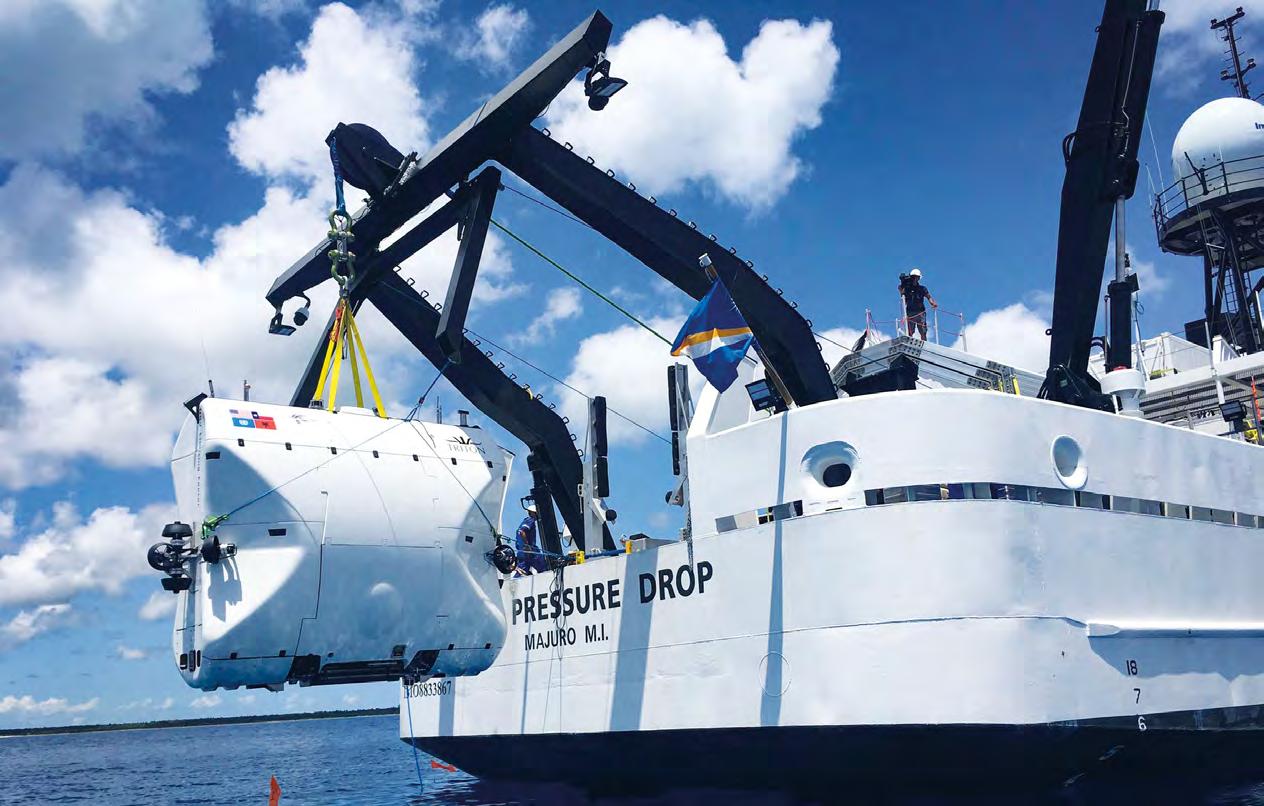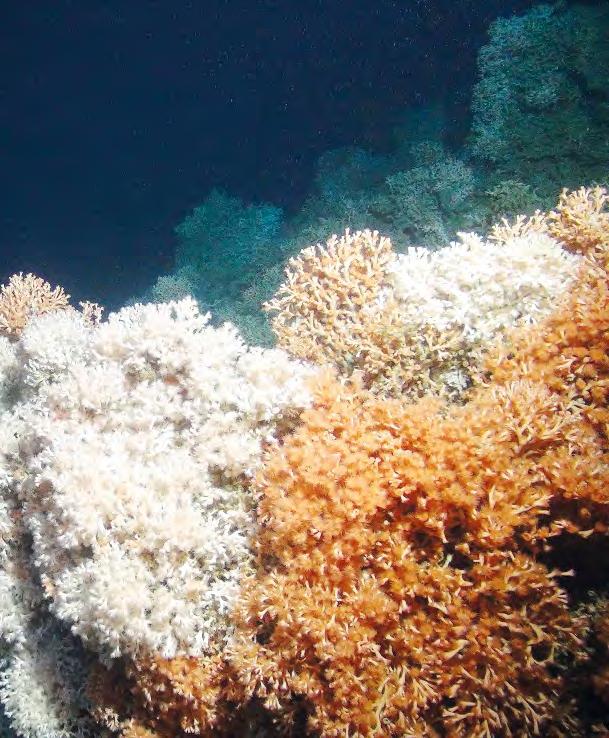
6 minute read
All At Sea - May 2020
by All At Sea
While we often hear about adventurers reaching the summits of the highest mountains, it is incredibly rare to come across a story about people exploring the depths of the world’s oceans. HOW DEEP IS DEEP?
been thrown overboard in the area, rather than taking them further offshore.
As you head westwards, there is a similar area off Start Point, but if you really want to give your echo sounder a work out then you have to carry on south and west towards the area known as ‘the Canyons’. Set in the far South West of the UK’s reach of the continental shelf, the area consists of two deep-sided canyons that each put Arizona’s Grand Canyon to shame, for at our underwater versions the depth drops precipitously away from just 100m to more than 2,000m.
An amazing environment is to be found in the two sites. The Explorer and Dangaard Canyons are home to some species not found anywhere else in UK waters, such as cold water coral, and are now the subject of an MPA, a Marine Protected Area.
Be it “in over your head” or “in too deep” we have lots of expressions that all refer to those times when we leave the shallow waters of the harbours and estuaries around our coast and head out into the more open sea. There is then the thrill as the depth sounder takes on a new persona, as the number on the screen grows bigger, telling you that you are now out on the ‘ocean deep’.
This is all very exciting, except for the fact that in depth terms, 99 per cent of us never actually get into what could really be described as deep water, for the UK is sat on a platform that provides a reasonably shallow shelf around our coast.
There are deeper areas, some of which feature in popular coastal locations, with one of the most accessible being just to the south and west of St. Catherine’s Point off the southern tip of the Isle of Wight. To achieve the record breaking five deep dives would take a voyage of some 47,000 miles and a total of 39 descents, with each adding to our understanding of the hadal zone which exists at depths below 6,000m. Image: Fivedeeps.com There is a fairly narrow slash in the seabed, with very deep water there, making it a prime location for getting rid of things that are best not recovered. SUNKEN SECRETS In 1936, after the death of King George V, his racing yacht, the Britannia, was sunk was sunk in this deep water. Old munition stocks were dumped in the area, with some rumours holding that WW1 gas shells had

DEEP FIVE Even deeper water can be found far out to the north and west of Scotland in the Rockall Trough, where depths of nearly 3,000m can be found. However, even these are mere shallows when compared with the deepest waters that are found around the globe, with the Challenger Deep, situated in the Mariana Trench, holding the record at 10,994m… that is a mile deeper than Mount Everest is high.
No one would claim that reaching the summit of Everest is easy, but it is reached by groups every year. In contrast, reaching into the depths is extraordinarily difficult, with it still being the case that more people have made it to the surface of the moon than have made it to the bottom of the Challenger Deep.
That number has now gone up by one, as explorer Victor Vescovo became the first person to do the ‘deep five’, when he reached the bottom of the deepest part of the five oceans.
To reach all of these depths in the same submersible would require a complete rethink of the technology required, as the previous deep dive vessels would complete a single dive before sailing into retirement. To achieve the deep five, Victor needed a submarine that could be reused multiple times, with only a short turn around period once back on the surface.
LIMITING FACTOR The result of extensive planning resulted in the ‘Limiting Factor’, a strange, teardrop shaped vessel with the main pressure hull being formed of a 90mm thick titanium shell. Built by Triton Submarines from their base in Sebastian, Florida, Limiting Factor was the brainchild of an English designer, John Ramsay, who graduated from Glasgow’s School of Art with a degree in Product Design Engineering. Other
Rare, fragile yet just as beautiful as the tropical corals, those found in cold water are just as much a foundation of the marine eco-systems as their more exotic relatives. Image: JNCC/Gov.uk

vessels that he has created can be seen on TV taking Sir David Attenborough into the deep.
Limiting Factor would pose John many new technical challenges, such as the thick acrylic windows that would nestle more deeply into the hull as the pressure increased and the need to provide sufficient power for extended periods at depth, for the intention was to not just reach the sea-bed but to do important scientific research once there.
Once construction and final testing was completed, it would be time for Victor to make his first dive, when in December 2018 he headed off to the deepest part of the Atlantic, at the Puerto Rico Trench, where he finally reached the bottom at a depth of 8,376m.
Next up would be the Southern Ocean, with the South Sandwich Trench, which was shallower at 7,433m, but is located in an area famous for the violence of the stormy weather.
POP DOWN TO TITANIC With successful expeditions completed, plus a bonus dive when they stopped for a quick trip 3,800m down to visit the remains of Titanic, the team headed east to the Indian Ocean, where Victor reached the bottom of the Java Trench at just 7,192m.
The stage was now set for the big one, the Challenger Deep in the Mariana Trench in the Pacific Ocean where at its deepest the water pressure is an incredible 1,086bar, or 15,750 pounds on every square inch of the vessel.
In May 2019 Victor took his craft down into the hadal depths (named after Hades, this is the hadopelagic zone, which is taken to start at 6,000m depth) and, by reaching the sea bed at a depth of 10,928m, set a host of new records in the world of deep diving.
He still needed one more dive, though, which he completed during August 2019, when he became the first person to ever reach the bottom of the Molloy Hole, 170 miles west of Svalbard, in the Arctic Ocean.
Close to the edge of the Arctic ice pack, this was potentially the most dangerous of the dives, but once completed Victor’s unique place in the history books was assured.
Moreover, our understanding of this super deep environment and the amazing wildlife that lives in the pressure and pitch dark has been greatly enhanced.
There was one dark moment, though, when Victor reached the bottom of the Challenger Deep, more than seven miles below the surface, he found the remains of a plastic bag on the seabed… When we think of coral we think of tropical seas and bright colours, yet in the waters around our shores we have sites were cold-water coral can be found.... jncc.gov.uk/our-work/the-canyons-mpa/#video


Collecting records and scientific data in equal measure, explorer Victor Vescovo standing alongside his submersible Limiting Factor. Victor had already been to the summit of Mt Everest, another record he now holds is that of the only man to get to the top - and the bottom of the world. Image: Fivedeeps.com / Tamara Stubbs





